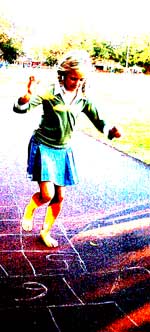Fitness Pages

Kids Fitness Tests
The tests that are used in the assessment of the fitness of school age children have been carefully selected to be appropriate to their level (see school testing programs). Some tests been adapted using lower weights, distances and times, and using simple instructions and modified equipment, while others are the same as for adults. Below are just some of the tests used on children.
Sit and reach test
The sit and reach test measures the flexibility of the lower back and hamstring muscles. The test involves sitting on the floor with legs out straight ahead, and then reaching as far forward as possible.
Sit Up Test
The sit up or curl up test measures abdominal strength and endurance. The child lies on the floor with knees flexed while a partner anchors the feet to the ground. The subject curls up their trunk then lowers back to the floor, repeating this as many times as they can in one minute.
Flexed Arm Hang
This test measures upper body relative strength and endurance. It has been adapted from the chin up test, as children and those with weak upper body strength are not able to do any chin ups at all. This test involves grabbing an overhead bar with arms bent and chin at the level of the bar, and trying to hold this position for as long as possible.
Beep Test
The beep test is a maximal exercise test to measure aerobic fitness. It involves running up and down a 20m track in time to increasingly faster beep signals. It is a maximal test, which means that the person must run until they are physically exhausted. There is no reason children should not be doing a maximal exercise test (it is more a problem for adults with sedentary lifestyles and other health issues doing the test with no preparation!). The test can be a great motivation tool for children to improve and learn to push themselves. Kids are pretty hardy things and there is no need to be soft on them!
Related Pages
- fitness testing programs for schools
- BMI measurement for children
- Health, Fitness & Nutrition
- Estimating Adult Height from your child's height
Other Links
- Conducting the Beep Test
